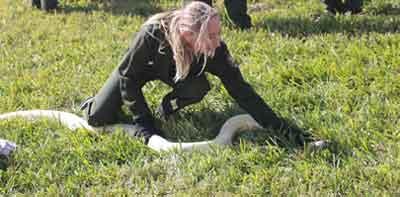Lots of occupations require some unusual skills, but it's pretty hard to top the list of tasks performed by employees at national parks all across the country. Staff and volunteers at Everglades National Park can now add another entry to that list: python catchers.
Perhaps a conversation something like the following has occurred in a household near the Everglades:
"Hi, mom! Welcome home. How was your day at work?"
"Oh, it was good, but pretty routine. I gave three guided walks, finished up some paperwork and caught a couple of ten-foot pythons."
For most of us, a "day at the office" doesn't involve outwitting larger-than-average snakes, but that's not unusual for some who work in this Florida park.
There's been plenty of press the past couple of years about problems with exotic snakes that have turned up in the Everglades, including reticulated pythons, common boa constrictors and ball pythons. The biggest problem thus far seems to be Burmese pythons, since researchers believe they're the only species from that list that's successfully breeding and reproducing in the park.
This group of invasive species provides a little good news and lots of bad—none of these species is poisonous, but their natural appetite is creating some potentially big problems for the South Florida environment.
The invaders survive by preying on native wildlife, and they aren't picky—the snakes’ tendency to feed on just about anything means these they could be a threat to endangered and protected birds and mammals found in the Everglades. Biologists fear these non-natives are upsetting the delicate natural balance of the nation’s only “River of Grass.”
The Burmese python is of particular concern, and it's making its presence known in the park and surrounding state lands, “They eat a wide range of prey, both in size and type,” said Skip Snow, a park wildlife biologist who helps identify the stomach contents of Burmese pythons dispatched on park lands. “We’ve even seen a bobcat.”
In case you've missed earlier stories about these creatures, you may be wondering how they got to the area in the first place. According to a park spokesman, "these invasive snake species were likely released into the Everglades by people who didn’t fully understand the demands of keeping reptiles that can grow to be eight to twenty feet long as pets. Burmese pythons and reticulated pythons are native to Southeast Asia. The common boa constrictor is native to Central and South America, and the ball python is native to Central and West Africa. All have been found sporadically in the Everglades since the late 1970s, but it is suspected that the Burmese python established breeding colonies in the mid-1990s."
Authorities in the park and on surrounding state and private lands are trying a number of tactics to help control the numbers of the snakes, and some recent training seeks to enlist additional help in the battle.
Everglades National Park, the Nature Conservancy, and Miami-Dade County Fire Rescue Department Venom Response Unit coordinated efforts to provide training to park staff from many divisions on how to appropriately capture these snakes. Maintenance, law enforcement, interpretive, volunteers and other staff members who are out in the park regularly are often the first to encounter one of these snakes. This training will provide those workers the skills to safely capture these snakes and transfer them to park wildlife biologists.
So, how was your day at work?


 Support Essential Coverage of Essential Places
Support Essential Coverage of Essential Places






